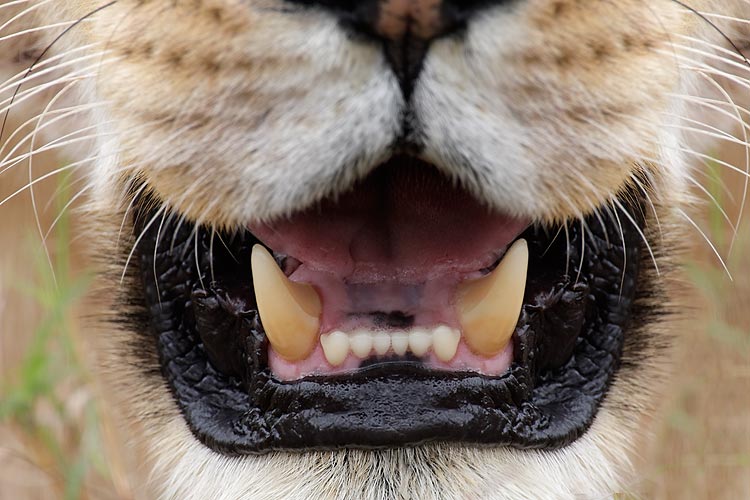
BIRDS AS ART BULLETIN #243
OCTOBER 1, 2007
Visit www.birdsasart.com
THE KENYA PHOTO-SAFARI REPORT
THE JOYS OF INTERNATIONAL AIR TRAVEL…
GITZO 3530 LSV CARBON FIBER TRIPODS BACK IN STOCK
POSSE NEWS
IPT UPDATES
Contact us by phone at 863-692-0906 (Eastern Time Zone) or by e-mail at birdsasart@att.net or birdsasart@verizon.net. The att e-mail address is best from overseas.
We gladly accept credit card orders by phone 8am till 9pm Eastern Time (8 am till 3pm Fridays).
You can use the PayPal links on the web site to order anything. Just type in the item(s) and the amount. If using your own PayPal account, please send to either of the e-mail addresses above.
Note: maximize this e-mail for best formatting.
Photographic theme: My favorite images from the recent Gustaphoto/BIRDS AS ART Kenya Photo-Safari.
Important Request: if responding to this e-mail, please take the time to delete all images and all irrelevant text.

African Lion, close-up of teeth, Keekorok Lodge, Maasai Mara, Kenya
Image Copyright 2007: Arthur Morris/BIRDS AS ART
Canon 500mm f/4L IS lens with the 2X II TC and the EOS-1D Mark III. ISO 500. Evaluative metering at zero: 1/200 sec. at f/11. Rig on old Wimberley head mounted on Todd-Pod.
I tried as best I could to make an image like the one above without any grasses covering some of the teeth on the left side (our right) of the lion's mouth, but was unable to do so as the beast lay panting right near our van and refused to budge. I created a Quick Mask of the right side of the jaws and teeth, flopped it, and moved it so that it covered the left side of the jaws and the teeth. As I have been doing this a while, I know that there are some folks who would label me as a cheat, a fraud, and a charlatan (and that is fine with me). My view is that I am using the latest technology to enable me to fulfill my photographic vision and that I have not altered the natural history of the situation (the original image depicted a nice set of lion's teeth and the optimized image depicts the same thing). I have created a stronger, cleaner, more dramatic image, and I have let folks know exactly what I have done.
Below is a small J-PEG of the (cluttered) original:
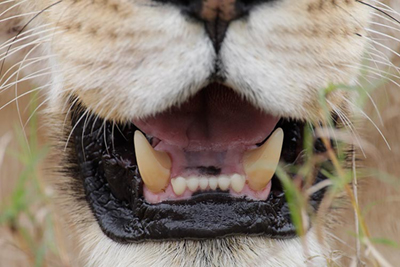
To learn to use Quick Masks, check out Robert O’Toole’s APTATS PDF here: http://www.birdsasart.com/aptats.htm
THE KENYA PHOTO-SAFARI REPORT
On September 10, I flew from Orlando to Amsterdam (via Detroit), and met most of the group early the next morning. I was co-leading The Gustaphoto/BIRDS AS ART 2007 Kenya Photo-Safari with Todd Gustafson. At about 10am, we connected with our flight to Nairobi. We were met at the airport by the great folks from Vintage Africa and over-nighted at the Jacaranda Hotel. On the morning of the 12th, we had assembled the entire group (missing only two pieces of luggage). With two leaders, the group totaled 15. Almost all of the participants were either IPT veterans or had traveled to Africa with us before (or both). Keith, Sharon, and David Kennedy from Milwaukee had attended the last two Fort DeSoto IPTs. Keith (photographer) had been to Kenya on business before but for wife Sharon (birder) and son David (photographer) Kenya was all-new and all-exciting. Sam Hogue (SW FLA 2006) and John Briedenbach from Beeville, TX were as delightful as any two folks could be (so they fit in perfectly). Bill Petrunich (DeSoto 2007) and wife Phyllis (a film point-and-shooter) were making their first safari. Bill was eager to learn and really paid attention to the program. I rode with him the last morning and he was teaching many of the concepts he had learned on the trip to Bob England, who had been to the Galapagos with me. Bruce Gauger (say GO-ger) both hard “g”s/Bosque 2006) was joined by daughter Janel (non-photographer). Tom Schwab, a doctor from St. Pete, had been on two bear trips plus an IPT or two. Roger McMunn, who had been to Africa with us before with his father-in-law, brought two Sigma 300-800 lenses! (He was staying on with Todd for a second Photo-Safari.) Last but not least was Hal (Hallagator) DuPont of Vero Beach; he brought one satellite and three cell phones and always serves as our logistical enforcer; if things at a given lodge were not absolutely up to standard, Hal quickly got things done. Hal, the patron saint of the Indian River Camera Club, has been on more than a dozen trips with me.
We had a big breakfast at the hotel and then drove to Wilson Airport to catch our flight to Keekorok Lodge in Maasai Mara. We had some great photography on the grounds of the lodge: hippos, bushbuck, Nubian Woodpecker, African Hoopoe, Little Bee-eater, and Red-fronted Tinkerbird among others. Our five drivers arrived with the luggage in mid-afternoon and in short order we were on our first game drive. Everyone was amazed when we quickly found five cheetahs on a kill. Over the course of the next four days, we got to photograph several lions (including a few on kills), lots of antelopes including Topi, Hartebeest, Eland, Impala, and Grants and Thompson’s Gazelles, Cape Buffalo, African Elephant, and more than a few bird species. In addition, there were many tens of thousands of migrating Wildebeests. We got to witness several river crossings. After an early morning game drive at Mara, we flew back to Nairobi with just our photo gear, and transferred to Naivasha Country Club.
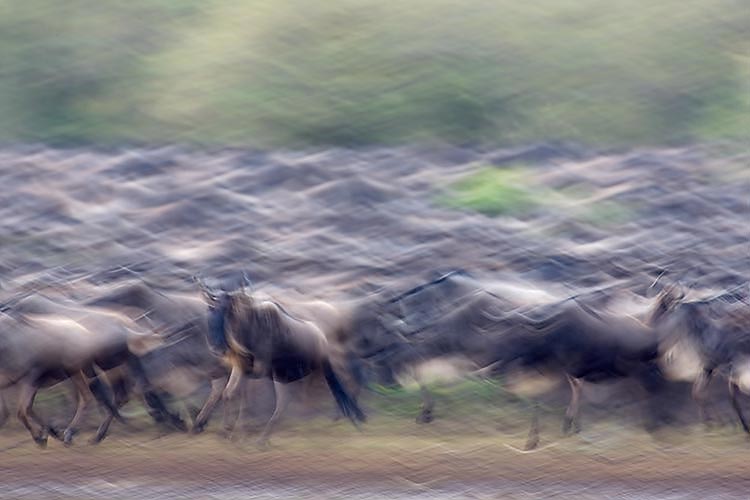
Wildebeest herd on the move, Maasai Mara, Kenya
Image Copyright 2007: Arthur Morris/BIRDS AS ART
Canon 500mm f/4L IS lens with the 2X II TC and the EOS-1D Mark III. ISO 50. Evaluative metering +2/3 stop: 1/6 second at f/11. Rig on old Wimberley head mounted on Todd-Pod.
We came across a huge group of wildebeest heading to the Mara River to cross at an inaccessible location. I remember advising the folks in my van and in the adjacent van to vary their shutter speeds and to try and place the green bush in the upper right-hand corner of the frame as a compositional anchor. I got really lucky with this one (but deleted every single one of the other 85 images that I made at the time...)
With the MIII it is necessary to disable Highlight Tone Priority if you wish to choose an ISO below 200. Our Mark III User’s Guide is full of great tips for folks who have purchased this great camera: http://www.birdsasart.com/MARK%20III%20USER%20GUIDE.htm
The original capture is below:
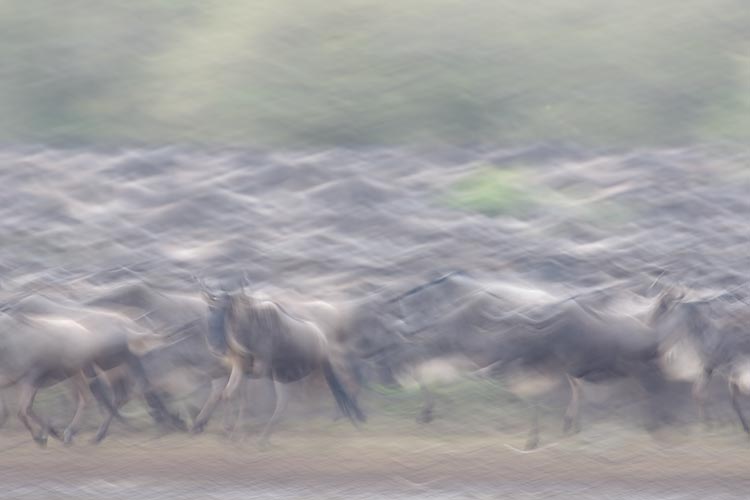
The converted RAW file looks washed out because it is properly exposed! In my new CD book, ABP II (http://www.birdsasart.com/ABPII.htm), we teach you how and why to expose to the right, and how to check your exposures by evaluating the histogram for each image. Simply put, ABP II can help you to become a better digital photographer. Our Photoshop workflow is simple and fast. The basic levels and curves adjustments used to optimize this image are detailed in both ABP II and in our Digital Basics file: http://www.birdsasart.com/digitalbasics.htm.
…..
For the next few days we photographed a variety of birds including Sacred Ibis, Yellow-billed Stork, and Blacksmith and Spur-winged Plover. In addition we found Vervet Monkey and Defassa Waterbuck on the grounds. We made two boat trips to Crescent Island where you get to walk with the herd animals. It is always an amazing experience; the highlight this year was a most cooperative three-day-old Maasai Giraffe. One afternoon we visited Elsamere; the Colobus Monkeys were not around, but a gorgeous Variable Sunbird made up for it. The next afternoon we visited a nearby fishing camp to photograph the Fischer’s Lovebirds; a White-headed Barbet at the nest tree was an unexpected bonus.
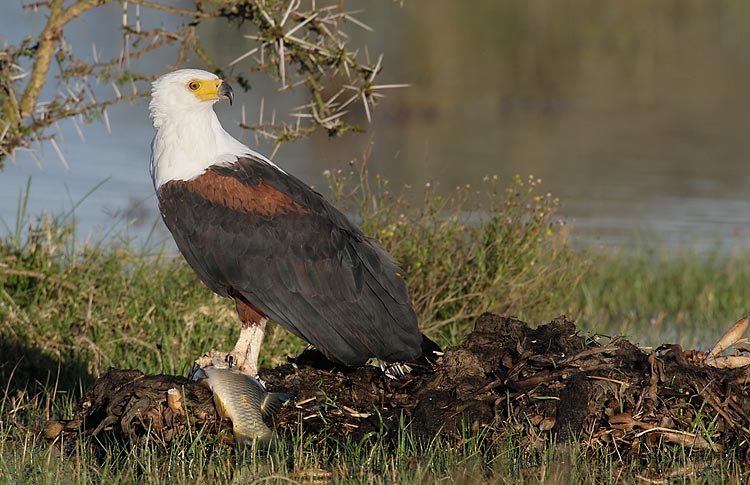
African Fish Eagle with fish, Lake Naivashsa, Kenya
Image Copyright 2007: Arthur Morris/BIRDS AS ART
Canon 500mm f/4L IS lens with the 2X II TC and the EOS-1D Mark III. ISO 400. Evaluative metering -1/3 stop: 1/400 second at f/14. Mongoose M3.5 on Gitzo CF 3530 LSV tripod.
I saw this bird land and had to cross a small pond (in my only pair of hiking boots…) to get into position to make this image. With the dark tones of the eagle’s upperparts I knew that I would need to dial in some minus compensation to keep from burning the white head.
…..
Next it was on to Lake Baringo with morning boat trips and afternoons on the grounds. The boat trips were huge success with African Fish Eagle, Pied, Malachite, and Pygmy Kingfishers, Squacco Heron, Little and Yellow-billed Egret, African Spoonbill, and Goliath Heron providing a wealth of subjects. After a morning boat trip on the 23, we loaded up the vans and drove to Nakuru for the grand finale.
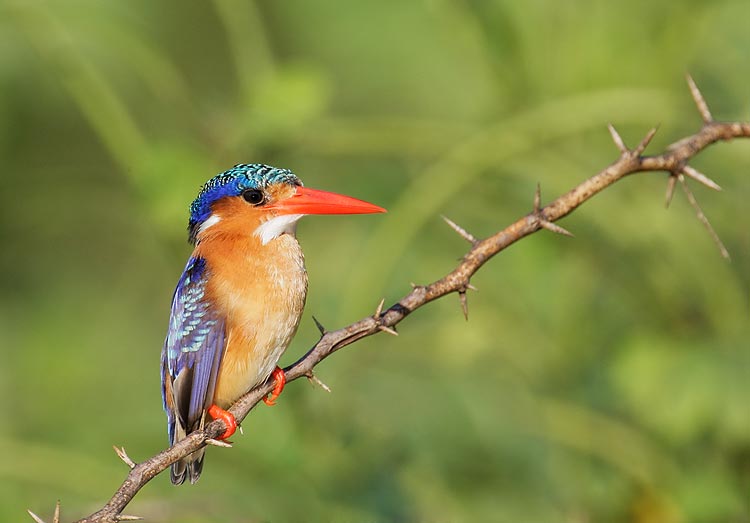
Malachite Kingfisher, Lake Baringo, Kenya
Image Copyright 2007: Arthur Morris/BIRDS AS ART
Canon 500mm f/4L IS lens with the 2X II TC and the EOS-1D Mark III. ISO 640. Evaluative metering at zero: 1/640 second at f/11 in Manual mode. M3.5 on Gitzo CF 3530 LSV tripod.
Working from a slowly rocking boat with two other photographers and forced to use the central sensor, I made sure to stay in AI Servo mode and place the sensor on the bird’s eye. I know that I would need to crop the original from the rear and the top to come up with a pleasing composition and that is exactly what I did.
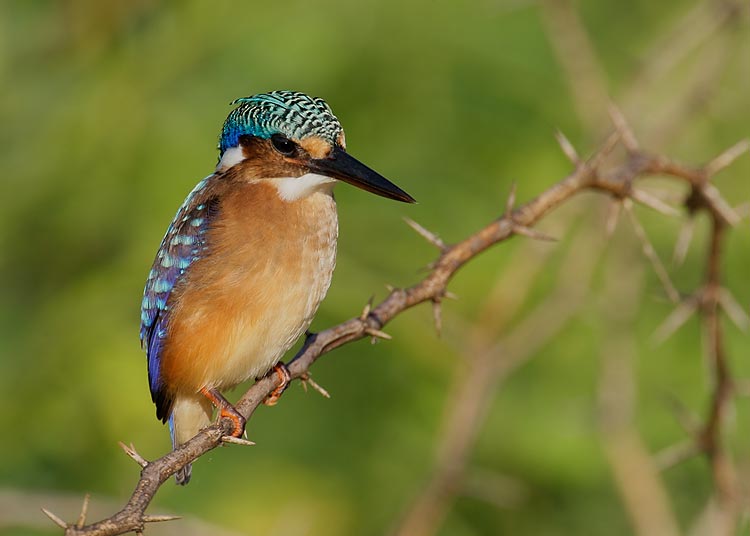
Pygmy Kingfisher, Lake Baringo, Kenya
Image Copyright 2007: Arthur Morris/BIRDS AS ART
Canon 500mm f/4L IS lens with the 2X II TC and the EOS-1D Mark III. ISO 500. Evaluative metering at zero: 1/500 second at f/11. M3.5 on Gitzo CF 3530 LSV tripod.
The next day I had a chance on this great and tiny bird from the boat. I used the same techniques to ensure a sharp image but as we got a bit closer I placed the sensor on the bird’s breast this time.
…..
Water levels at Lake Nakuru had been dropping for the past few years, but with lots of rainfall this year, things were back to normal, normal being about three million Lesser Flamingoes. On our second morning yours truly came up with a new way to photograph the flamingoes taking flight against clean blue-water backgrounds. On the third morning about half of the group joined me… We did spectacularly well at Nakuru National Park which is basically a very huge zoo with a fence around it. The animals are far tamer than at Maasai Mara. In addition to the flamingoes, there were lots of African White Pelicans, many hundreds of Cape Buffalo, both Black and White Rhinos, hippos, Rothschild’s Giraffe, Olive Baboon, and lots, lots more. Yikes; I almost forgot my best Leopard ever. With our drivers positioning us perfectly, everyone in all five of our vans had some great opportunities. Before we knew it, we were on our last morning game drive and soon were on the road to the Carnivore Restaurant in Nairobi. After a great lunch we utilized our day-rooms at the Jacaranda to re-pack, shower, and rest up a bit. After some last minute shopping we kissed Todd good-bye, headed for Jomo Kenyatta Airport, and began the long trip home…
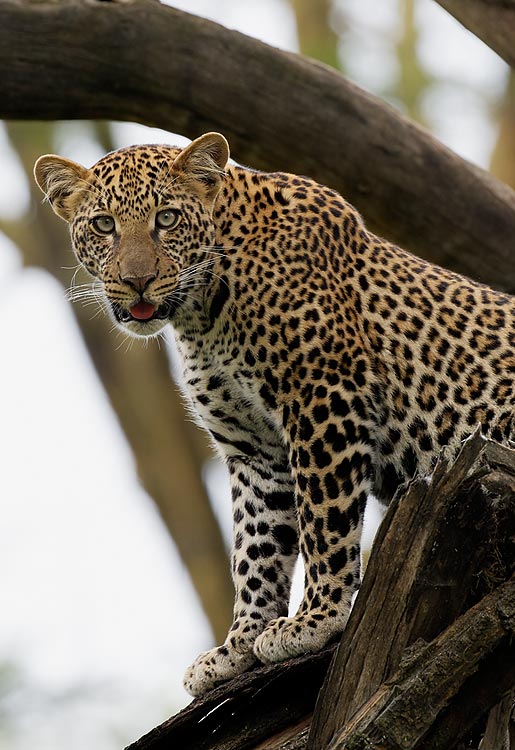
Leopard, Nakuru National Park, Kenya
Image Copyright 2007: Arthur Morris/BIRDS AS ART
Canon 500mm f/4L IS lens with the EOS-1D Mark III. ISO 500. Evaluative metering +2/3 stop: 1/160 second at f/9. Rig on old Wimberley head mounted on Todd-Pod.
We all dreamed of a cooperative Leopard and were thrilled when Kim found this one on his lunch break and led all of us to it.
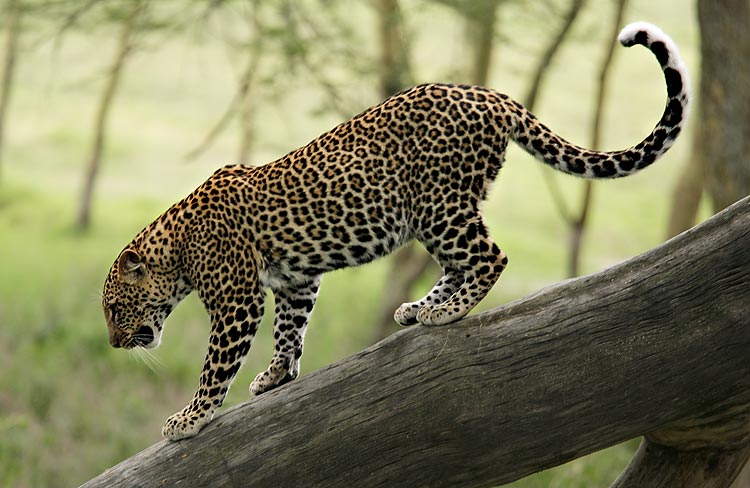
Leopard, Nakuru National Park, Kenya
Image Copyright 2007: Arthur Morris/BIRDS AS ART
Canon 70-200mm f/4L IS zoom lens with the 1.4X II TC (handheld at 280mm) with the EOS-1D Mark III. ISO 800. Evaluative metering at zero: 1/400 second at f/5.6.
Though the composition is perfect, the cat’s tail is curved and does not merge with the tree just behind it, and the background is enchanting, this image was not as sharp as I would have liked. I used a contrast mask (as described in ABP II and Digital Basics) to boost the apparent sharpness.
…..
We did lots of image sharing on the trip. I am proud of the images that I made and felt that I had a great safari. Yet everyone (including me) who saw Todd’s amazing images day after day always had the same question, “What safari was he on?” Todd’s skills are perfectly suited to photographing from the top of a safari van. He is strong, fast, strong, smart, strong, and has an amazing knowledge of animal behavior. He consistently creates spectacular images while those in the same van (including me) are left fumbling with their equipment. A bit after Todd returns from his back-to-back safaris, we will feature a gallery of his images from the trip. The best news of all is that Todd is almost finished with a how-to photograph on safari book. It will be available through BAA. (I am currently working hard editing the book.)
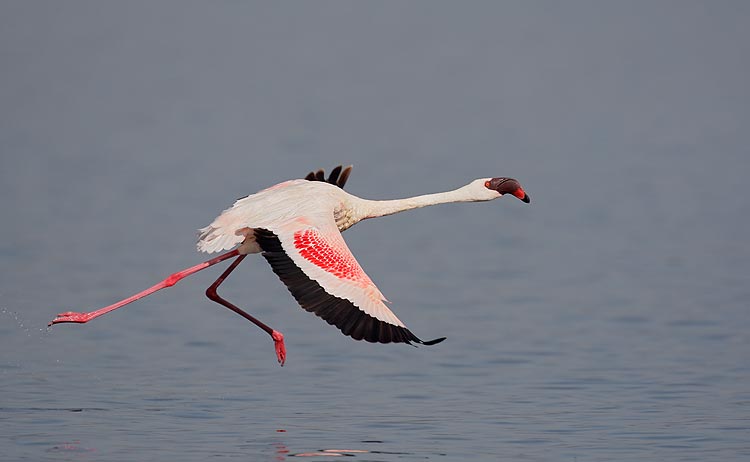
Lesser Flamingo, non-breeding plumage, Lake Nakuru, Nakuru National Park, Kenya
Image Copyright 2007: Arthur Morris/BIRDS AS ART
Canon 500mm f/4L IS lens with the 1.4X II TC and the EOS-1D Mark III. ISO 400. Evaluative metering at zero: 1/2000 sec. at f/7.1 in Manual mode.
Once I found the perfect spot from which to photograph the flamingos and formulated my plan, creating images like this was child’s pay; it was pretty much a slaughter…
THE JOYS OF INTERNATIONAL AIR TRAVEL…
To make a long story a bit shorter… On the way home I was scheduled to fly from Amsterdam to Minneapolis and connect with a flight that arrived in Orlando at 5:47pm, but I had a somewhat tight international connection of 1 hour, 50 minutes. At Nairobi Airport the agent told me that I was not booked for the flight to Minneapolis so I showed her my itinerary and gave her the confirmation code. After about 15 minutes she came back with boarding passes for the flights to Amsterdam and to Minneapolis, but said that I would need to get the boarding pass for the Orlando flight once I got to Minneapolis. She was unable to check my bags all the way to Orlando…
We had a big tailwind and arrived in Minneapolis 50 minutes early. My bags were among the first off of the carousel and I breezed through customs. When I was re-checking my bags the agent told me that Flight 584 was “not operating.” It turned out that the flight no longer existed. NW/KLM had changed my reservation and not bothered to tell me. And the agent in Nairobi missed the changes, as did the agent in Amsterdam. I learned that I had been re-routed through Detroit and should have arrived in Orlando at 6:06 pm. Instead, they booked me on the Orlando flight at 7:48 pm that evening; this represented more than an 8 ˝ hour layover due entirely to NW/KLM’s ineptitude. The flight wound up leaving almost an hour late. We hit the ground in Orlando at 30 minutes after midnight and I did not get home until 3:40 am. The door-to-door trip from the lodge at Nakuru to my home in Indian Lake Estates, FL had taken 50 hours and 40 minutes. With my body-clock totally wrecked, I did not get to sleep until 6:40 am. I woke at 8:40 am, stumbled around like a Zombie most of the day, took a four hour nap at 2pm, and am still a bit jet-lagged… I have filed a complaint with NW Customer Service asking for either an $8,000 refund on the cost of my Business Class ticket ($9861.86), or for a credit of 240,000 miles in my World Perks Account…
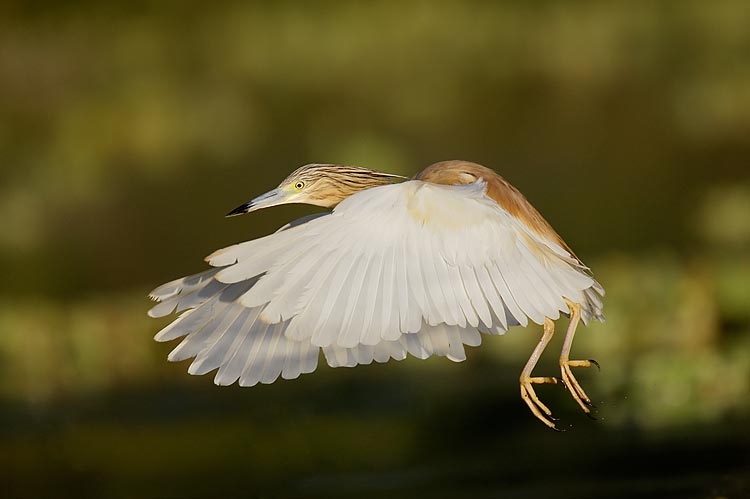
Squacco Heron landing (images above and below), Lake Baringo, Kenya
Image Copyright 2007: Arthur Morris/BIRDS AS ART
Canon 500mm f/4L IS L lens with the 1.4X II TC from a boat with the EOS-1D Mark III. ISO 800. Evaluative metering +1/3 stop: 1/3200 sec. at f/5.6 (above) and 1/4000 sec. at f/5.6 (below).
In bright sun with a background other than sky the Mark III performed flawlessly here and produced two extremely sharp images (in only a two frame sequence). Photographing birds in flight off a tripod from a cramped boat is not easy…
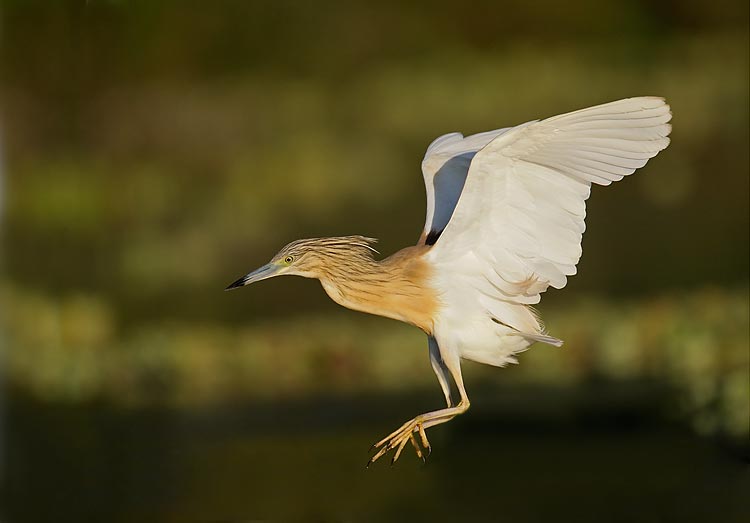
GITZO 3530 LSV CARBON FIBER TRIPODS BACK IN STOCK
Because Bogen kept us back-ordered for months while sending an ample supply of 3530 SLV tripods to B&H, many of even our most loyal customers were forced to purchase their tripod from B&H when they would have preferred to order from us. Dozens of our loyal customers placed their orders with us and wound up having to cancel as we received virtually no tripods for about two months. Bogen simply do not appreciate that it is the little guys like us are who inform the public of the best new products. We are sorry that until now we were unable to fill so many orders, but we now have an ample supply of 3530 tripods in stock. (The 3530 is best for most folks. See the info below on the 3540 XLS for tall folks and the 5540LS for photographers who want the absolute maximum in sturdiness, strength, and rigidity. )
The popular 3530 LSV (three leg sections/4 lbs), which replaces the CF 1325, has been extremely short supply since its release several months ago. This is the tripod that I use every day with both my 500 and 600 mm f/4L IS lenses. I also use this tripod for macro, and—with the Mongoose 2.3—whenever I need a tripod-mounted intermediate telephoto. We are currently out-of stock and back-ordered, but are expecting our next shipment of 12 soon. It is my understanding that BIRDS AS ART has received more 3530s than any other US supplier including B & H. At present, we only have two or three folks on our wait list so if you need a 3530, the all-purpose CF tripod, it would be best to place your order with us. We will not bill your card until the item ships.
The 3540XLS (four leg sections/4.3 lbs) is for tall folks, 6’ 4” or taller. Todd Gustafson, all 6’ 8” of him, asked me to get him a 3540XLS after hearing good things about it from multiple IPT veteran Bob Wilmschen. I was, however, leery of the rather thin lowest leg sections and suggested that Todd only partially extend the bottom sections. After following my advice, here is what he had to say:
“They finally did it!! They came up with a tripod that I can shoot with in complete comfort. For years I used the heavy Gitzo 410. The height came to just below my chin. It was almost tall enough to shoot flight with but didn't pack down small enough to fit in a regular suitcase. When Gitzo integrated carbon fiber technology into their tripods I switched to the lighter 1548 model thinking I was saving lots of weight. The 1548 folded down to a convenient suitcase size but was still too short. I moved the center column from the 410 tripod to the 1540 so that I could make flight shots in comfort. After shooting a week of jungle birds in Costa Rica I couldn't figure out why my back hurt so much. I realized that the whole tripod set up still wasn't tall enough and that with the center column the 1548 was only one pound lighter than the old 410.
Enter the new line if Gitzo Carbon 6X tripods. My new GT3540XLS model stands an amazing 77" tall! I can stand at full height in comfort and shoot into the jungle canopy or make flight shots with no back pain. The new carbon technology has cut the weight to just over 4 pounds while still providing enough strength to support a 600mm lens, a pro camera body, and a flash setup. The setup and breakdown time on the 1548 model was 45 seconds or more and required 2 hands. With the GT3540XLS I can break down and setup in 10 seconds with one hand due to the new independent leg-locks! Even with the added height it easily fits into a suitcase. And best of all, my images are sharp, even those created at shutter speeds as low as 1/60 second.”
The GT5540LS (four leg sections/6.5 lbs) replaces the CF 1548, but is lighter, stiffer, and stronger. We recommend this model for folks with 400mm f/2.8 or 600 mm lf/4 lenses that do not feature IS or VR technology, and for those who—in their efforts to create the sharpest possible images—demand the most rigid long lens CF tripod available.
Here are our current prices. You will find that we undercut even the mighty B & H by a few cents.
Gitzo GT3530LSV Carbon Fiber 6x Tripod (Lots now in stock): $649.94 + $15 US shipping
Gitzo GT3540XLS Carbon Fiber 6x Tripod (1 in stock): $745.99 + $15 US shipping
Gitzo GT5540LS Carbon Fiber 6x Tripod (2 in stock): $784.99 + $15 US shipping
Florida residents need to add 7% sales tax to the cost of the tripod only. Overseas customers please e-mail at birdsasart@att.net for shipping costs (and be sure to include your complete ship-to address).

Maasai Giraffe, 3-day old running with umbilical cord still attached, Crescent Island, Lake Naivashsa, Kenya
Image Copyright 2007: Arthur Morris/BIRDS AS ART
Canon 500mm f/4L IS lens with the 2X II TC and the EOS-1D Mark III. ISO 1600. Evaluative metering +2/3 stop: 1/320 second at f/8. Mongoose M3.5 on Gitzo CF 3530 LSV tripod.
Again, the Mark III performed perfectly auto-focusing accurately with the 2X TC in low light.
POSSE NEWS
Robert Amoruso
is offering the following Wildscape Images 2008 Workshops:
Merritt Island NWR/Viera Wetlands/Canaveral National Seashore Photographic
Instructional Workshop,
January 11, 12 and 13, 2008. Includes morning and afternoon in-the-field
photography sessions and evening instructional sessions at some of the most
diverse wildlife and avian photography locations in Central Florida.
(Registration on this tour includes a free copy of Robert’s MINWR Site Guide.)
St. Augustine Alligator Farm Photographic Instructional Workshop, March 28, 29 and 30, 2008. Includes morning and afternoon in-the-field photography sessions and instructional sessions covering exposure, composition and correct use of flash. The Alligator Farm is one of the best places to learn how to use your flash.
Avian Boat Tours
are designed to offer experienced photographers access to a variety of lake and
estuary locations in Brevard, Osceola and Indian River Counties in Central
Florida. Though there is lots of in-the-field instruction, there are no formal
classroom sessions with the boat tours; Robert will be by your side to answer
your questions and to help you create some amazing images. Participants will
have a chance to share images during lunch. Contact Robert to schedule one
today: 407-808-7417 (cell phone) or
info@wildscapeimages.com
For details, including costs, visit
www.wildscapeimages.biz.
Jim Neiger asked me to mention that he still has a single opening on his first Bosque Flight School Workshop (NOV 10-12, 2007/Slide program on the evening of NOV 9: $899) and lots of room on the calendar for folks who wish to join him on his Custom/Anytime workshops.
You can learn more about the workshops (including the recently announced Best of Florida Workshops) and see some of Jim’s amazing photographs here:
http://www.flightschoolphotography.com/Workshops/Current%20Workshop%20Pages/FSP%20Current%20Workshops.htm . You can contact Jim as follows: cell phone/407-247-5200; or e-mail: jimn@cfl.rr.com
Robert O’Toole’s Bosque APTATS workshops are limited to 6 participants. All are welcome; you do not need to be signed up for an IPT to join Robert to enjoy a day of great Photoshop instruction. Discounts for groups of 2 or more are available. Please e-mail Robert at robert@robertotoolephotography.com for more info or to register.
Bosque #1:”The Fall Color IPT” APTATS Workshop: NOV 12th, 2007. $399: 1 opening.
Bosque #2:”The Pre-Thanksgiving IPT” APTATS Workshop: NOV 16th, 2007. $399: 3 openings.
Bosque #3:”The Post-Thanksgiving IPT”APTATS Workshop: NOV 21st, 2007. Sold out.
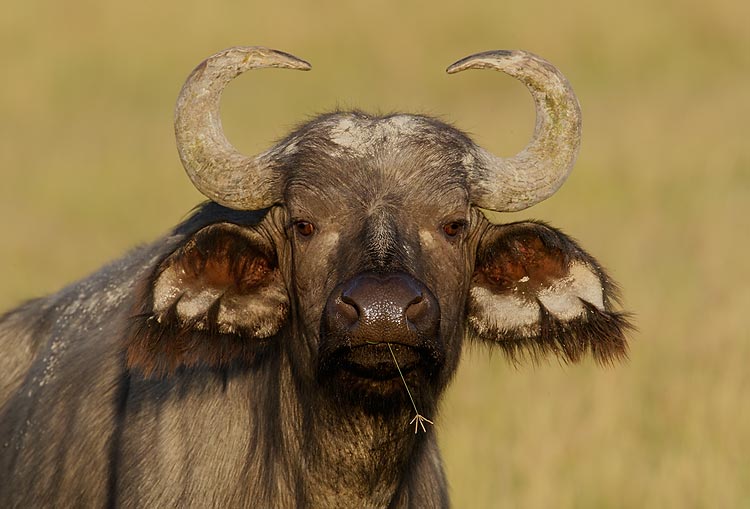
Cape Buffalo, Nakuru National Park, Kenya
Image Copyright 2007: Arthur Morris/BIRDS AS ART
Canon 500mm f/4L IS lens with the 1.4X II TC and the EOS-1D Mark III. ISO 500. Evaluative metering at zero: 1/250 sec. at f/10.
This animal had character (and lovely, mud-stained ears). There were lots of tame Cape Buffalo at Nakuru.
IPT UPDATES
Note: All presently scheduled North American IPTs except San Diego (see same below) are currently sold out with waiting lists.
Bosque #1: "The Fall Color IPT" NOV 13-15, 2007. Slide Program on the evening of NOV 12. 3-DAY: $999. (Limit 14; Sold Out). Co-leader: Robert O'Toole. Guest leader (DAY 3 only): Andy Rouse. This IPT should feature a better chance for a day or two of the rare south winds that drastically improve flight photography and will definitely feature the brightest fall-color cottonwoods.
Bosque #2: "The Pre-Thanksgiving IPT" NOV 18-20, 2007. Slide Program on the evening of NOV 17. 3-DAY: $999. (Limit 14; Sold Out). Co-leader: Robert O'Toole, Robert Amoruso, & Alfred Forns. Guest leader: Andy Rouse. This IPT will feature increasing numbers of geese and cranes with lots of great opportunities. In 2007, I will again be hosting a Thanksgiving Day luncheon at Las Lunas Mansion, a fine restaurant in an historic building. You will need to reserve a spot and pay in advance. Details TBA; strictly limited to 50 folks.
Bosque #3: "The Post-Thanksgiving IPT" NOV 24-26, 2007. Slide Program on the evening of NOV 23. 3-DAY: $999. (Limit 14: Sold Out). Co-leaders: Robert O'Toole, Robert Amoruso, and Alfred Forns. This IPT is scheduled on dates that I consider peak for Bosque. (There may be a Full Moon Add-on NOV 23; details TBA.) If you register for this one, hold off on buying your plane ticket if you might be interested in the add-on.) In 2007, I will again be hosting a Thanksgiving Day luncheon at Las Lunas Mansion, a fine restaurant in an historic building. You will need to reserve a spot and pay in advance. Details TBA; strictly limited to 50 folks.
SW FLA Post X-mas IPT: DEC 27-29, 2007. Slide program on the of evening Wednesday, DEC 26, 2006. 3-DAY: $1029. (Limit 12; Sold Out). Co-leaders: Alfred Forns, Robert O'Toole, & Robert Amoruso. Joining us as guest co-leader will be full time professional photographer John Moran, Florida's unofficial Photographer Laureate. You can learn about John’s amazing work here: www.johnmoranphoto.com. John will be doing his program, “Journal of Light: A Photographer's Search for the Soul of Florida" for the group on Wednesday, DEC 26 at 3:30 pm. John’s work is so different from mine and from everyone else’s that he has been a huge inspiration to me over the past two years. We will be visiting Sanibel Island, Venice Rookery, Cape Coral, and possibly Little Estero Lagoon (depending on the tides). Herons, egrets, gulls, terns, skimmers, shorebirds, both pelicans, Osprey, Burrowing Owl, and lots more. Roseate Spoonbill and Wood Stork possible.
San Diego IPT: JAN 20-23, 2008. Slide program on the Saturday early evening of JAN 19. 4-DAYS: $1399. (Limit 12; openings: 8.) LaJolla, LaJolla Shores Beach, Coronado, and Santee Lakes. Brown Pelicans in spectacular breeding plumage, Heerman’s & Western Gulls, Marbled Godwits & lots more shorebirds, Wood & Ring-necked Ducks & Lesser Scaup. Great flight photography. And lots more.

Lesser Flamingo panorama; the view from Baboon Cliffs, Lake Nakuru, Nakuru National Park, Kenya
Image Copyright 2007: Arthur Morris/BIRDS AS ART
Canon 500mm f/4L IS lens with the 1.4X II TC and the EOS-1D Mark III. ISO 400. Evaluative metering +1/3 stop: 1/160 sec. at f/11.
This image was created by stitching together 5 horizontal images in Photoshop CS3. David Kennedy talked me through the basics of creating successful panoramic images: wait for constant light, set the exposure manually, and focus manually just once. Here I focused about 1/5 of the way up the frame in the first panel on the right. .
Best and love and great picture-making to all,
artie
Note: Arthur Morris has been a Canon contract photographer since 1994 and continues in that role today. Hunt's Photo of Boston, MA is a BAA sponsor as is Delkin Devices. Back issues of all BAA Bulletins can be found in the Bulletin Archives which may be accessed from the home page at www.birdsasart.com